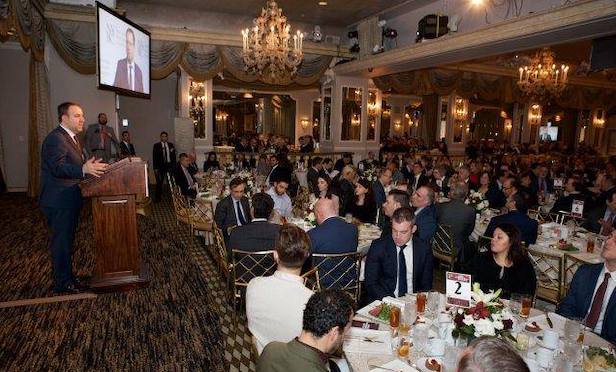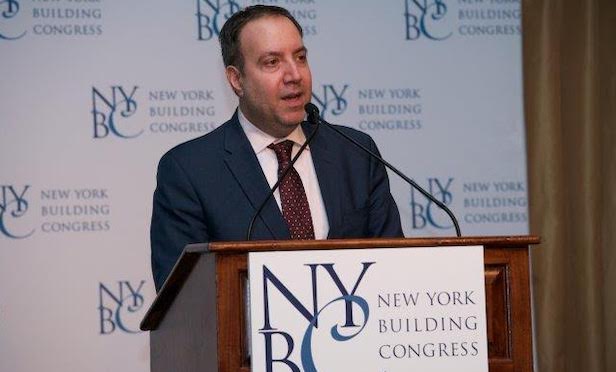 Carlo Scissura, NYBC CEO and president, annual meeting, The Pierre Hotel Grand Ballroom/ Photo credit: NYBC
Carlo Scissura, NYBC CEO and president, annual meeting, The Pierre Hotel Grand Ballroom/ Photo credit: NYBC
NEW YORK CITY—The New York Building Congress released its agenda for this year, which will push for city, state and national infrastructure plans.
At the professional organization's annual meeting at The Pierre Hotel Grand Ballroom, First Deputy Mayor Dean Fuleihan, and Lorraine Grillo, the department of design and construction commissioner, presented the city's blueprint on improving its capital projects. The plan reflected Mayor Bill de Blasio's announcement on reforms for the department. It included ways to modernize the procurement process, streamline projects including orders and payments, increase training for project managers and upgrade technology.
NYBC president and CEO, Carlo Scissura, reviewed his organization's 2019 Policy Agenda that promotes productive capital spending, encourages public-private partnerships and positions the organization to serve as a guiding voice in significant government projects. NYBC will roll out a media plan to help the public better understand and appreciate the construction industry's role in the city. It also will host Ascend 2019, a real estate technology conference.
 Carlo Scissura, CEO and president of the New York Building Congress/ Photo credit: NYBC
Carlo Scissura, CEO and president of the New York Building Congress/ Photo credit: NYBCThe NYBC 2019 Policy Agenda set forth its goals:
Federal
(1) It will advocate federal funding for the northeast rail corridor and for the Gateway Project. This would rehabilitate two tubes crossing the Hudson River, and construct two new passenger rail tunnels that connect NY and NJ. The rail corridor is 457 miles connecting Washington, DC, Baltimore, Philadelphia, New York and Boston. The agenda states this is the county's highest density of people, employment and economic productivity and it accounts for 20% of all US jobs.
(2) NYBC will push for a comprehensive $3 trillion national infrastructure plan. It notes the dire situation with the American Society for Civil Engineers giving the country's bridges a D+ and roads a D-.
State
(1) It will support Governor Andrew Cuomo's infrastructure goals. This includes MTA's $29 billion, five-year capital plan; New York State DOT's $22 billion, five-year capital plan; and the governor's “Justice Agenda,” proposing a $150-billion infrastructure plan.
(2) It will back congestion pricing.
(3) NYBC will seek to update state construction laws to expedite and reduce costs with public procurement and delivery.
(4) Especially with the closure of the Indian Point Energy Center, the Building Congress will promote a clean, affordable energy plan.
(5) The organization will rally behind passing a law protecting the building industry from liability when responding to a declared emergency.
(6) It will keep the interests of the city's region high on Albany's list. This includes NYCHA, Brooklyn and Queens infrastructure and transportation, the Port Authority, Rikers Island's closure and building community jails, and the Second Avenue subway.
New York City
(1) NYBC will work towards a five-borough infrastructure investment strategy. This includes the city's appointment of an infrastructure council with representation from all boroughs.
In addition, the Building Congress has also recently published its report on affordable housing. Reviewing city data, the study concluded New York City is on pace to reach Mayor Bill de Blasio's goals of 300,000 units of affordable housing by 2026, with 40% being new construction. From January 2014 through July 2018, 34,482 new affordable housing units have been built. The majority of this construction has been in the Bronx and Brooklyn.
The report states since January 2014 of affordable units, 79% were preserved or built due to tax credits. NYBC praises the mayor for making affordable housing one of his signature priorities with the current administration exceeding its goals.
Nonetheless, Scissura concludes, “The lack of affordable housing for New Yorkers is an emergent and worsening crisis. Member of the design, construction and real estate industry must continue to work with the mayor's office to remedy this housing shortfall and keep New York City a great place to live.”
© Touchpoint Markets, All Rights Reserved. Request academic re-use from www.copyright.com. All other uses, submit a request to [email protected]. For more inforrmation visit Asset & Logo Licensing.







